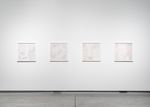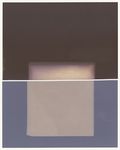January 15 - February 28, 2021 - Maine College of Art
←
→
Page content transcription
If your browser does not render page correctly, please read the page content below
January 15 – February 28, 2021 The Institute of Contemporary Art at Maine College of Art 522 Congress St., Portland, ME 04101 www.meca.edu/ica
ELIZABETH ATTERBURY Elizabeth Atterbury’s (Portland, ME) recent solo and group shows include Mrs., Queens; Kate Werble Gallery, New York; The Portland Museum of Art, Portland; The Colby College Museum of Art, Waterville; kijidome, Boston; DOCUMENT, Chicago; Western Exhibitions, Chicago; The Luminary, St Louis; Et al. Etc., San Francisco; Pulaski Park Field House, Chicago; Able Baker Contemporary, Portland; Ida Schmid, Brooklyn; TSA, Brooklyn; Bodega, Philadelphia /New York; KANSAS, New York; and The ICA at Maine College of Art, Portland, among others. In the Middle, An Oasis, a monograph of her work, was published by Bodega Press in 2013. She received her BA from Hampshire College and her MFA from MassArt. TAD BECK Tad Beck’s (Vinalhaven, ME) solo exhibitions include Los Angeles County Museum of Art, CA; Fisher Center at Bard College; Annandale-on-Hudson, New York; Samuel Freeman Gallery, Santa Monica; Marisa Del Re Gallery, New York; Nathalie Karg Gallery, New York; Center for Maine Contemporary Art, Rockland; and Grant Wahlquist Gallery, Portland, Maine. Beck’s collaborative work with the artist Jennifer Locke was exhibited at Los Angeles Contemporary Exhibitions. Group exhibitions include the Wadsworth Atheneum; Fotofest International, Houston; Spritmuseum, Stockholm; the Addison Gallery of American Art, MA; the Portland Museum of Art, ME; the Worcester Art Museum, MA; the Ogunquit Museum of Art, ME; Apex Art, NY; Rupert Goldsworthy Gallery, NY; and Castelli Gallery, NY. His work is in the collections of the Addison Gallery of American Art, Los Angeles County Museum of Art, Wadsworth Atheneum, Portland Museum of Art (ME), Worcester Art Museum, Museum SAGE LEWIS, Cache, Inkjet print on backlight film, acrylic sheet, 2021. of Fine Arts Houston, and Princeton University Art Museum. SAGE LEWIS Sage Lewis’ (Tunbridge, VT and Brooklyn, NY) recent exhibitions include Temporary Surface, Hamad bin Khalifa University Art Gallery, Doha, Qatar; Material Inference, Denison Museum, Granville, OH; and Fixed/Fluxed, Burlington City Arts, Burlington, VT. Lewis has taught at Ohio State University, VCUQatar; and been a visiting artist at Denison University, College of the Atlantic, and Hartwick College. Lewis recently completed a Project Space Residency at the Visual Studies Workshop in Rochester, New York and a 10-month Artist-in-Residence Fellowship at Virginia Commonwealth University in Qatar. A forthcoming artist book titled Mars Analogues will be published by the Visual Studies Workshop. AMANDA MARCHAND Amanda Marchand (Brooklyn, NY) is a Canadian, New York-based photographer. Her work explores the human condition through the poetics of landscape with an experimental approach to photography. Marchand’s recent exhibitions include, Lensculture Awards, Galerie Joseph, Paris, France; Fresh 2019, Klompching Gallery, New York; Synesthesia, The Space Between, Datz Museum of Art, South Korea, Material Memory, Outside Gallery, North Adams, MA, and The World is Astonishing, at Traywick Contemporary, Berkeley, CA. Her monographs, Nothing Will Ever Be the Same Again (2019), and Night Garden (2015) were published by Datz Press. Marchand is a MacDowell Colony and Headlands Center for the Arts Fellow. She has also attended residencies at Datz Museum, the Hermitage Artist Retreat, the Studios at MASS MoCA, The Bakery Photo Collective, Hewnoaks Artist Colony, and Arteles Creative Center (Finland).
Parallax / Geography The experience of distance can allow for thinking, for determining the shape of
the “real” — or as Virginia Woolf put it: “the feeling of the singing of the real world.”
Parallax / Geography exhibits the work of four artists whose use of the photographic Perhaps the real, in fact, is this space of consideration, the gray area, and that felt
medium negotiates the slippery retreat of the real from the camera’s eye, extending space of longing to stitch together near and far. The photographic works of Sage
the distance and longing that retreat provides. Using experimental processes Lewis bring to mind the documentation of earthworks produced by Land Artists of the
and conceptually driven structures, these works revisit the classic materials of 60s and 70s in the US Southwest. As with documents by Smithson or Heizer, Lewis’
photography: time, light, space, and substrate. The term parallax refers to the works exist as a vision of a place we can’t easily access. Photographing the distant
apparent displacement of an object when seen from differing points of view. We geology of Mars, Qatar, and the US West, Lewis establishes a tactile and intimate
use parallax to see: each eye provides a subtly different sightline that our brains relationship with far-off places. Viking Lander stills, Mars Rover imagery, satellite
then stitch together, creating our perception of depth. Through photographing images from Google Earth, and artist documentation are all brought into relationship
constructed spaces, reflection, light effects, and distant geology, each of these artists with paper, backlight film, acrylic and rubber substrates. The reach of the camera’s
navigate distance, landscape, desire, and time through the medium of photography. lens seems to touch distant geology. Rocks and grains of sand appear to float, seeking
purchase. The work exposes and constructs a new geomorphology of embedded
Elizabeth Atterbury’s photographs of constructed spaces allude to architecture, layers and surfaces, a dialog between capture and materiality that eludes our grasp,
landscape and language. The works share a relationship with her sculptural processes between distance and proximity.
and evidence an enduring interest in abstraction, arrangement, and artifact. In The
Well, The Wall, one can imagine the shimmering of light across a surface full of A lumen print is a cameraless photographic process, like a photogram. In translating
depth, as well as witness the more mundane clarity of the flat construction — and the action of sunlight directly to photographic paper, the process interprets the
ELIZABETH ATTERBURY, Left: Beach Works (Marks of a tool II), Silver Gelatin Print, 20 X 24 in., 2016.
photograph — impenetrable, before you. In Logogram I, one’s eyes travel through a Right: The Well, The Wall, Silver Gelatin Print, 20 X 24 in. 2016, Cover: Logogram I, 20 X 24 in. 2016.
root meaning of photography — light writing— quite literally; no lens or camera is
scaffold-like structure, into the picture plane. The work leads us to question language required. In Amanda Marchand’s works, the lumen process reveals how each unique
as a system of symbols and meaning making, one that evolves through our use photographic paper is comprised of a different chemical makeup, offering up a
and play. In Black Beach, abstract forms and the traces of movement in sand seem spectrum of color. The temporality of the lumen process demands Marchand’s works
to depict a kind of language in the making, one whose meaning remains distinct capture light over time— the longer the time frame, the greater the depth of color, or SAGE LEWIS, Grounded lightbox No. 1 (Mojave Desert, Amargosa Range, Agra, Grapevine Mountains, and
and distant. Echoing the explorations of early modernist forbears such as László “burn”, on the paper. We witness this ongoing process as a series of gradations and Mars Chryse Planitia (the Plains of Gold) / Utopia Planitia). Inkjet prints mounted on acrylic, 2021.
Moholy-Nagy, or recent works of contemporary practitioners like Erin Shirreff, that layers reminiscent of the horizon. In Mary Lucier’s 1975 work Dawn Burn, the path
upend perception and play with the relationship between three-dimensional and of the sunrise on consecutive days is literally burned on the camera’s light sensitive
two-dimensional space, Atterbury’s photographic works make space for our own picture tube (in this case video), reflecting on time and the landscape, as much as
philosophical investigations, asking questions with answers that lie just out of reach. the inscription of light. Similarly, Marchand’s works reflect on the path of the sun,
about 93 million miles away, as it moves through our days, and its role in cultivating
Tad Beck’s Blanks series begins by capturing what is, essentially, a blank piece of our earthly existence. In Out in the Sun (One Day), a book left on the paper leaves
paper. Through repeated iterations, and the build-up of time as much as composite behind its imprint, a negative. In Marchand’s Timeline (Dusk), we may imagine the
layers, the works reveal a gathering interplay of light and shadow reflected onto gradual transformation of celestial hues as we move from civil twilight, through
that surface. Compared to Alvin Lucier’s seminal work, I am sitting in a room, which nautical to astronomical twilight, as the sun retreats from view. The works highlight
emphasized the resonant frequencies of a particular room, Beck’s work emphasizes the relationship between time and the horizon.
the subtle play of light over time through particular windows in his studios. While not
privy to the view outside the window, one can grasp hints of color and form within So much lies beyond reach. Striving toward distant goals is part of our humanity.
the layers that allude tangentially to the surroundings. In works from the Figureheads The distance seduces and invites us, provoking our attention and action. These
series, the carved wooden ornaments representing wealth, identity, and vision on ships photographs find ways to bring the faraway close by, to navigate differing spatial
in early ocean voyages are recalled. That vision, frequently associated with unseen and temporal scales, and present us with the elasticity of both. In bringing the world
or unknown locations and the brio necessary to ward off uncertainty, aligned too with in close we see it simultaneously retreats from our grasp. Compressing space and
spiritual guidance and protection from malevolent forces. Here a real human subject time, stitching together here and there, the artists in Parallax/Geography present us
— sensual, alluring — is presented to us through occluded vision; a flash of light blinds with longing as a productive state, a state of active attention and great depth.
the viewer and presumably the subject. C apsize 4 equally inverts our vision, the
subject withdrawn or complicated by the photographer’s use of a water drop as a
lens. Upon closer inspection, a window reflection within the drop cues us to unknown TAD BECK, works from the series “Blanks”, Archival Inkjet Prints Unique, 24 X 24 in., 2018– 2019.
processes at work in the artist’s studio. Through their distances, Beck’s works extend Parallax / Geography is organized by Director of Exhibitions Julie Poitras Santos.
and often complicate the conditions of desire and the role of the camera’s eye in The exhibition is on view from January 15 – February 28, 2021 at the Institute of AMANDA MARCHAND, Left: Event Horizon (Violet), AGFA Multicontrast Classic MCC 111 FB gloss, 17.5 X 24 in.,
revealing and constructing it. Contemporary Art at Maine College of Art. 2020. Right: Out in the Sun (One Day), Oriental VC FB2 warmtone, 24 X 30 in., 2020.The Institute of Contemporary Art at Maine College
of Art cultivates engagement and dialogue regarding
contemporary visual art practices, aiming to foster
discourse on the critical conversations of our time
and to enhance understanding of visual culture.
Located in stunning galleries in Maine © Institute of Contemporary Art at Maine College
College of Art’s landmark Porteous Building, of Art. All rights reserved. No part of the contents
the ICA at MECA presents an exhibition of this publication may be published without the
written permission of the Institute of Contemporary
calendar of ambitious work by living artists
Art at Maine College of Art.
accompanied by public events and artist
talks, operates as a learning laboratory for Installation photography: Joel Tsui. Works by
MECA students, and as a center for public Elizabeth Atterbury courtesy of the artist and
programming regarding contemporary art Document Space, Chicago. Works by Tad Beck
that engages with the local, national and courtesy of the artist and Grant Wahlquist Gallery,
global art community. Portland.You can also read























































